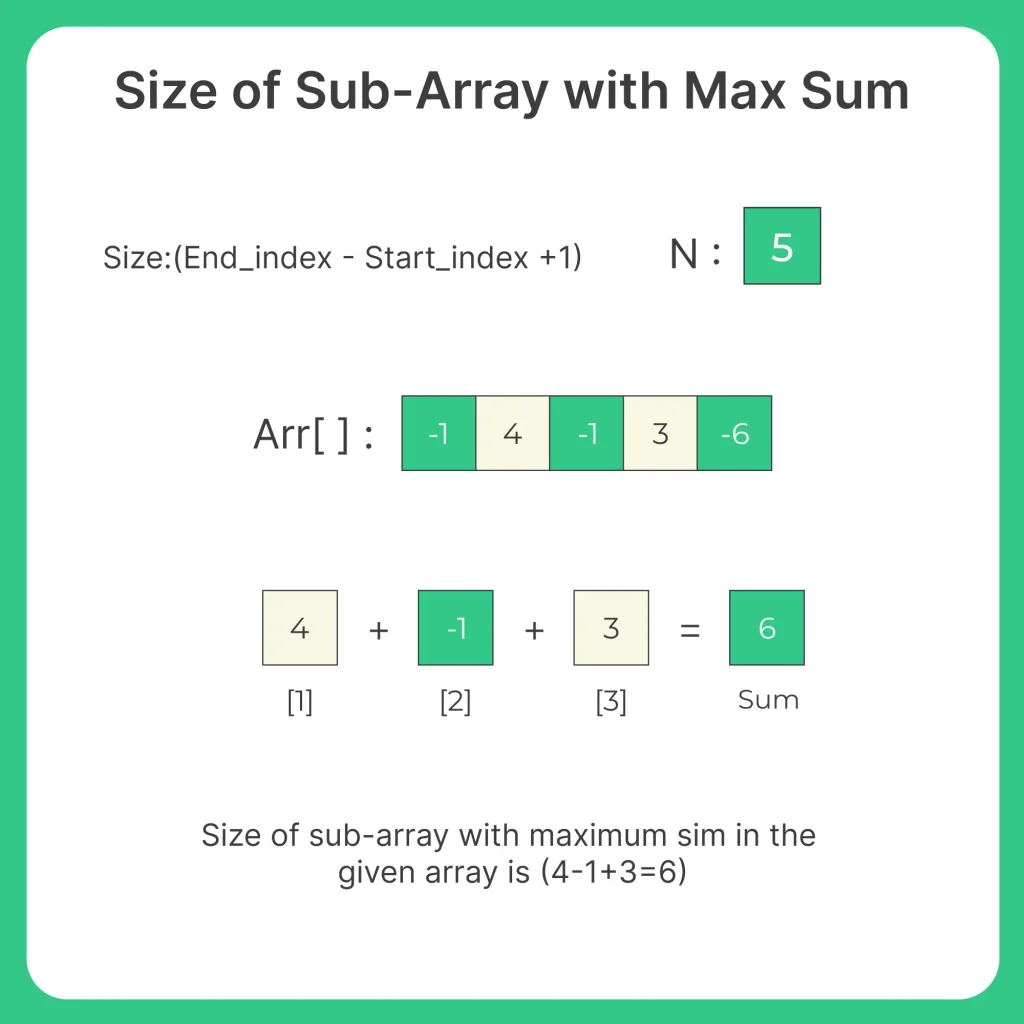Size of sub-array with max sum in C
Size of sub-array with max sum
Here, in this page we will discuss the program to find size of sub-array with max sum in C. We use Kadane’s algorithm, which runs in O(n) time.
The idea is to keep scanning through the array and calculating the maximum sub-array that ends at every position. If current sum becomes 0 then at that point we also update the starting index.

What is the Sub-array with Maximum Sum?
A sub-array is a contiguous part of an array. The maximum sub-array sum problem is to find the sub-array (containing at least one number) which has the largest sum.
The goal of this problem is to not only find the sum, but also to determine the size of this sub-array.
Size of sub-array with max sum in C
The size of the sub-array with the maximum sum in an array is the number of elements that are part of that sub-array.
For example, in the array
[1, -2, 3, 5, -3, 2], the sub-array with the maximum sum is [3, 5], and its size is 2.
To find the size of the sub-array with the maximum sum in C, you can modify the Kadane’s algorithm implementation to keep track of the size of the sub-array as well.

Algorithm:
Create two intermediate variables max_ending_here and max_so_far .
And also two variables start and end for tracking start and the end index of the subarray with maximum sum.
Initialized these two intermediate variables using the 0.
Traverse the array from 0 to N-1 and calculate the max_ending_here and max_so_far.
Now we will keep max_so_far which indicates the maximum sum found so far.
- During the scanning of the elements from starting, and when the max_ending_here becomes 0 at that point we also update start and end variables.
Prime Course Trailer
Related Banners
Get PrepInsta Prime & get Access to all 200+ courses offered by PrepInsta in One Subscription
Kadane’s Algorithm
Kadane’s algorithm is used to solve this problem efficiently by scanning the array once and maintaining a running sum.
Key Variables Used:
- max_ending_here: Maximum sum of sub-array ending at the current index
- max_so_far: Maximum sum so far
- start, end: Indices of the sub-array with the maximum sum
- s: Temporary starting index
How the Algorithm Works:
- Initialize all variables to 0.
- Traverse through the array.
- Add the current element to max_ending_here.
- If max_ending_here becomes greater than max_so_far, update max_so_far and note the start and end indices.
- If max_ending_here becomes negative, reset it to 0 and update the temporary start index s.
C code for Size of sub-array with max sum
#include<stdio.h>
int maxSubArraySum(int a[], int size)
{
int max_so_far = 0, max_ending_here = 0,
start =0, end = 0, s=0;
for (int i=0; i< size; i++ )
{
max_ending_here += a[i];
if (max_so_far < max_ending_here)
{
max_so_far = max_ending_here;
start = s;
end = i;
}
if (max_ending_here < 0)
{
max_ending_here = 0;
s = i + 1;
}
}
return (end - start + 1);
}
int main()
{
int a[] = {-7, 3, 4, -1, -12, 1, -9, -3};
int n = sizeof(a)/sizeof(a[0]);
printf("Size of subarray with maximum sum is : %d",maxSubArraySum(a, n));
return 0;
}
Output
Size of subarray with maximum sum is : 2
Time and Space Complexity
- Time Complexity: O(n) — we go through the array only once.
- Space Complexity: O(1) — only a fixed number of variables are used.
Method:2
#include
int maxSubArraySize(int a[], int n) {
int max_sum = a[0];
int size = 1;
for (int i = 0; i < n; i++) {
int current_sum = 0;
for (int j = i; j < n; j++) { current_sum += a[j]; if (current_sum > max_sum) {
max_sum = current_sum;
size = j - i + 1;
}
}
}
return size;
}
int main() {
int a[] = {-2, -3, 4, -1, -2, 1, 5, -3};
int n = sizeof(a) / sizeof(a[0]);
printf("Size of subarray with maximum sum is: %d", maxSubArraySize(a, n));
return 0;
}
Output
Size of subarray with maximum sum is: 5
Time and Space Complexity
Time Complexity: O(n²) — Two nested loops check all sub-arrays.
Space Complexity: O(1) — No extra space used.
Closing Thoughts
Understanding how to find the size of the sub array with the maximum sum is crucial for mastering array based problems in C. By using Kadane’s Algorithm, we can efficiently solve this problem in linear time with constant space, making it suitable for large data sets.
This approach not only helps in identifying the maximum sum but also tracks the exact size of the sub array that contributes to this maximum sum. Mastery of this logic is essential for optimizing performance in technical interviews and competitive coding.
FAQs
Kadane’s Algorithm helps find the sub array with the maximum sum in linear time by maintaining a running sum and updating indices when a higher sum is found.
Track the starting and ending indices of the sub-array when the maximum sum is updated, then calculate size as end – start + 1.
Yes, the sub-array can contain negative numbers as long as the overall sum is the highest possible among all sub-arrays.
The time complexity is O(n) as we traverse the array once, and the space complexity is O(1) because only a few variables are used.
Get over 200+ course One Subscription
Courses like AI/ML, Cloud Computing, Ethical Hacking, C, C++, Java, Python, DSA (All Languages), Competitive Coding (All Languages), TCS, Infosys, Wipro, Amazon, DBMS, SQL and others




Login/Signup to comment